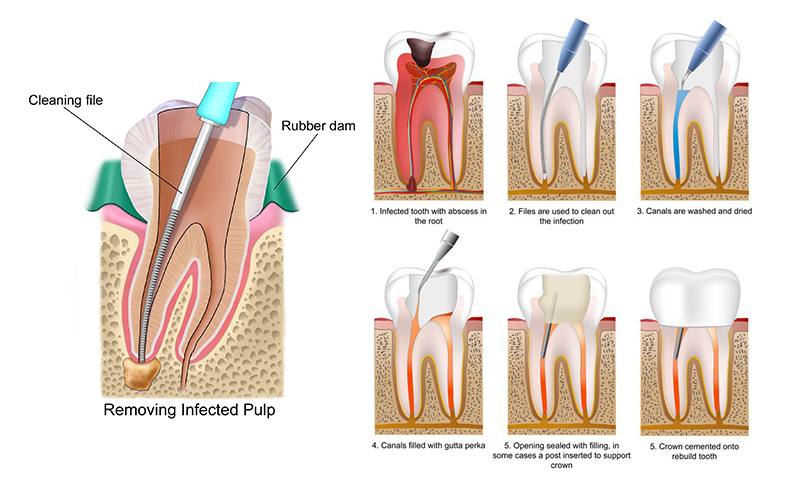WHAT IS ROOT CANAL?
Nothing is as good as a natural tooth! And sometimes your natural tooth may need root canal (endodontic) treatment for it to remain a healthy part of your mouth. Most patients report that having root canal (endodontic) treatment today is as unremarkable as having a cavity filled.
Teeth are held in the jaw by their roots. Inside each tooth is the “pulp” or “nerve” which supplies nourishment and sensation to the tooth. Root canals are very small, thin canals that branch off from the pulp chamber down to the tip of the root. A tooth has at least one but no more than four root canals.
When the pulp or root canal is diseased or injured, it “dies”. If you don’t remove the dead tissues your tooth gets infected and you could lose it. Inflamed or infected pulp (pulpitis) most often causes a toothache. To relieve the pain and prevent further complications, the tooth may be extracted (surgically removed) or saved by root canal treatment.
Root canal treatment is a dental procedure in which the diseased or damaged pulp (core) of a tooth is removed and cleaned out of any infection in the pulp and root canals.The inside areas (the pulp chamber and root canals) are filled and sealed.
WHAT ARE THE SIGNS OF NEEDING ENDODONTIC TREATMENT?
- Prolonged sensitivity to heat or cold
- Spontaneous pain or throbbing of the tooth
- Pain while biting or chewing
- Tenderness to touch and chewing
- Drainage and tenderness in the lymph nodes as well as nearby bone and gingival tissues.
- Deep cavity
- Cracked, chipped or split tooth
- Discoloration of the tooth
- Gum (periodontal) disease
- Trauma, such as a sudden blow to the mouth
- For many damaged pulps or root canals there are no symptoms. Your dentist may discover a “dead” tooth in an x-ray.
WHAT MAKES A ROOT CANAL NECESSARY?
Regardless of the initial cause, the tooth pulp becomes irritated and infected. Bacteria grows within the tooth pulp, causing pressure and if a cavity forms and is allowed to go untreated for too long, it can penetrate to the root pulp where and infection can occur pain, sometimes accompanied by swelling of the face. Sometimes the deterioration of the pulp happens so gradually that little pain is felt. Regardless of the amount of pain felt, eventually the bacteria can destroy the pulp.
WHAT WILL HAPPEN IF YOU LEAVE THE TOOTH UNTREATED?
Regardless of the initial cause, the tooth pulp becomes irritated and infected. Bacteria grows within the tooth pulp, causing pressure and if a cavity forms and is allowed to go untreated for too long, it can penetrate to the root pulp where and infection can occur pain, sometimes accompanied by swelling of the face. Sometimes the deterioration of the pulp happens so gradually that little pain is felt. Regardless of the amount of pain felt, eventually the bacteria can destroy the pulp.
If a tooth has an abscess it can firstly cause severe pain, but not always. Some abscesses can be surprisingly painless. Nevertheless, the infection at the root tips can spread into the surrounding bone and soft tissues and cause more serious infections there that could cause swelling and pain. Bacteria also enter the blood stream and can infect other parts of the body. Prosthetic hip and knee joints and heart valves are particularly prone to infection. Patients with other health problems could also be at higher risk.
PROCEDURE : endodontics

Root canal treatment is performed under local anesthesia. A thin sheet of rubber, called a rubber dam, is placed in the mouth to isolate the tooth. The dentist removes any tooth decay and makes an opening through the natural crown of the tooth into the pulp chamber. Creating this access also relieves the pressure inside the tooth and can dramatically ease pain.
The dentist determines the length of the root canals, usually with a series of x rays. Small wire-like files are then used to clean the entire canal space of diseased pulp tissue and bacteria. The debris is flushed out with large amounts of water (irrigation). The canals are also slightly enlarged and shaped to receive an inert (non-reactive) filling material called gutta percha. However, the tooth is not filled and permanently sealed until it is completely free of active infection. Once the canals are completely clean, they are filled with gutta percha and a sealer cement to prevent bacteria from entering the tooth in the future.
GETTING STARTED : ENDODONTICS
STEP 1
Find an Endodontist (usually same-day treatment)
STEP 2
Attend continuing treatments
No longer have to wonder whether after root canal treatment will cause tooth pain again or not. because root canal treatment teeth The nerve of the tooth will be removed, so there will be no more pain. Endodontic treatment has obvious advantages that can preserve the teeth for further use and is better than dentures. This is because root canal teeth, like other teeth in the mouth, have a bony socket to hold the teeth strong and provide a better feel than dentures.
During root canal treatment,
it is important to follow certain practices. There is no need to worry about experiencing toothache after the treatment because the nerve of the treated tooth is removed, so there should be no pain. One clear advantage of root canal treatment is that it allows you to preserve and use your natural tooth, which is better than having a dental implant. A tooth that has undergone root canal treatment is just like any other tooth in your mouth. It is firmly supported by the surrounding bone and provides a solid and natural feeling, which is superior to wearing a dental prosthesis.
COMPLICATIONS
- For the first few days after treatment, your tooth may feel sensitive, especially if there was pain or infection before the procedure. Because of the infected nature of the abscess there can be some discomfort or swelling. This will be controlled with antibiotics and anti-inflammatories as needed. This discomfort can be relieved with over-the-counter or prescription medications. Follow your endodontist’s instructions carefully.
- Your tooth will feel sensitive to biting pressure. This feeling is a result of the nerve endings in the tissue outside the end of the root where it was cleaned, irrigated and a filler or sealer material was placed.
- Also, you might feel a rough area where access was made by your Endodontist. There is a soft, temporary material in that area, which may appear to wear away to some degree before your next dental visit.
- Your tooth may continue to feel slightly different from your other teeth for some time after your endodontic treatment is completed. However, if you have severe pain or pressure or pain that lasts more than a few days, call your endodontist.
SPECIAL CARE AFTER ENDODONTIC TREATMENT
Once the root canal treatment has been completed, you should consider the following: Brittleness a non-vital (endodontically treated) tooth is more brittle than a vital one and is more susceptible to fracture. Placing a suitable final restoration is almost as important as the root treatment itself. If the restoration leaks bacteria can migrate down the side of the root sealer and re-infect the tooth. In most cases, we recommend that your root canal tooth be crowned (gold or porcelain crown) following treatment.
Loss of tooth structure from dental caries (cavities), prior fillings, and endodontic care frequently results in weakening of the tooth. Teeth which are structurally weakened are prone to fracture, which can lead to tooth loss. A special restoration called a post-and-core is commonly needed to reinforce weakened teeth and a good way to insure against a serious fracture is to crown the tooth.
Discoloration you may notice that your endodontically treated tooth (especially a front tooth) has undergone a change in color. Though this discoloration is of no medical concern, you may be interested in having the teeth whitening. Be sure to ask us about Tooth Whitening if we do not decide to place a crown on the tooth.
FAQ: ENDODONTICS
Q: What is Root Canal Treatment?
A: is the removal of the tooth nerve and the pulp in the infected tooth cavity to relieve pain or save a tooth.
Q: How long can a tooth survive after root canal?
A: Teeth that have been treated or rehabilitated can stay alive if proper care is observed.
Q: What are the common signs Root Canal is needed?
A: These are symptoms to watch out for:
- Severe toothache
- Intolerable sensitivity to cold or hot
- Darkening of tooth
- Swelling of gums
- Persistent pain or swelling
Free consult, Booking now...
For those who are interested in orthodontics and cosmetic dentistry at reasonable prices Denta-joy Dental Clinic is a specialist in this field. We are ready to provide advice and treatment by specialist doctors. You can ask for more details at
Line Official: @dentajoy
โทร 095-491-8659


